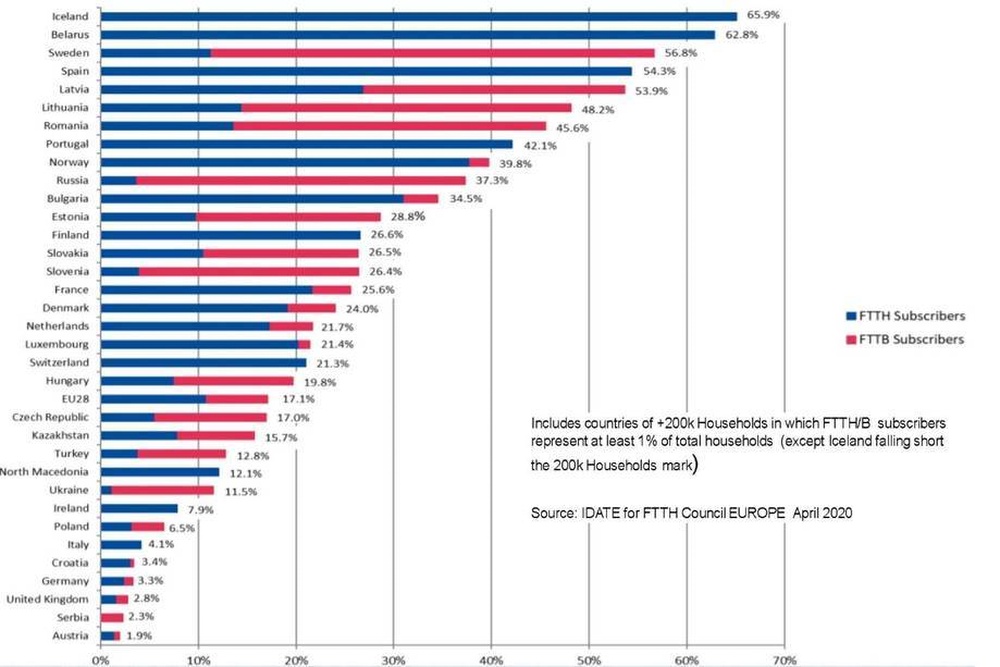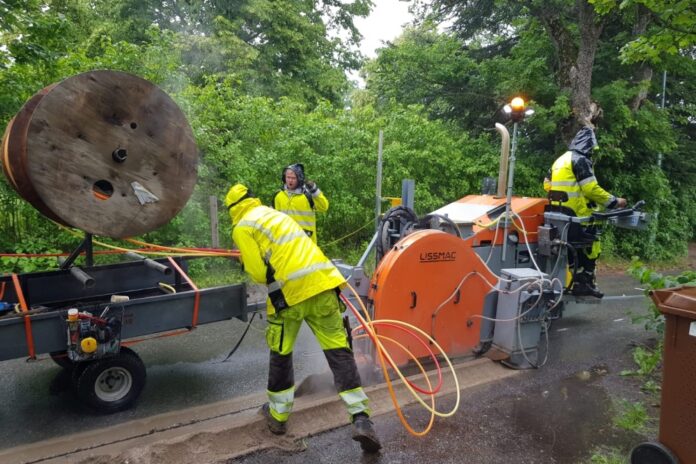France, Italy and Spain have the biggest increase in the number of homes passed since the last Council Panorma figures were published.
There has been a 15% growth in the number of fiber subscribers during the reporting period – the year to the end of September 2019.
The FTTH Council’s 2020 Market Panorama and were prepared by IDATE.
The total number of homes passed with Fibre to the Home (FTTH) and Fibre to the Building (FTTB) in the EU39[1] reached nearly 172 million homes compared to 160 million in 2018, with 19 countries counting more than 2 million homes passed.
The main movers in terms of homes passed in absolute numbers are France (adding 3.5 million), Italy (adding 1.9 million) and Spain (adding 1.5 million).
The top five regarding annual growth rates, in terms of homes passed, is headed by Belgium (307%), Ireland (70.4%), Switzerland (69.1%), the UK (50.8%) and Germany (33.5%).
Almost half full
The coverage[2]of both FTTH and FTTB networks in September 2019 was almost 50%. By September 2019, the EU39 reached a 49.9% coverage of FTTH/B networks while EU28[3] hit 39.4%, compared to respectively 46.4% and 36.4% in 2018.
This shows a clear upward trend from the September 2015 figures when the coverage was at 39.8% in EU39 and 27.2% in EU28.
The number of FTTH and FTTB subscribers in Europe increased by 15.0% in EU39 since September 2018 with 70.4 million FTTH/B subscribers in September 2019.
Russia still plays a major role in this increase, however, it is interesting to note that the EU28 experienced a 20.9% increase on its own.

Subscriber numbers
This year[4], the country adding the most subscribers is located in Western Europe. France added 1,923,000 new FTTH/B subscriptions and Spain came second adding 1,650,820 new FTTH/B subscribers.
Others with an outstanding increase isubscribers are Greece (285%), Ireland (185%), Switzerland (176%), Belgium (111%) and Italy (45.3%).
By September 2019, the EU39 FTTH/B take-up[5] rate rose to 40.9% in comparison to the 37.4% rate registered by September 2018.
For the second consecutive year, the take-up rate for EU28 surpassed that of the EU39 by reaching 43.3% (as opposed to 38.2% in September 2018).
Fibre technologies have been continuously evolving during the last few years with FTTH architecture surpassing FTTB (60% vs 40%).
Alternative internet service providers are still constituting the largest part of FTTH/B players, with a contribution of around 56% of the total fibre expansion.
Some 41% of homes are passed by former incumbent operators. This number will also evolve as some of the latter have modified their strategy deploying more FTTH solutions, migrating from copper- and cable-based networks towards fibre, and even intensifying copper switch-off.
Growing roles
The role of governments and local authorities is also increasing, either directly thorugh signed agreements with telcos, or via public funding.
“Ubiquitous and reliable digital infrastructure has never played such a crucial role as today connecting families, enabling business activities and working from home. Very high capacity connectivity is not only mission critical in times of crisis but will also be fundamental for economic recovery and the transition towards a sustainable, green EU economy.” added Erzsébet Fitori, outgoing Director General of the FTTH Council Europe.
“Competitive investments in very high capacity networks should, therefore, remain a high political priority and we look forward to working with the EU institutions, national governments and [national regulatory authorities] towards removing bureaucratic and other barriers from the way of network deployment. Access to very high capacity networks faster and more cost efficiently benefits everyone.”
European FTTH/B ranking
Iceland knocked Latvia off top spot it held for the last three years, with a penetration rate of 65.9% [6] rate, with Latvia now coming in fifth (53.9%), behind second place Belarus (62.8%), then Sweden, which with 56.8% reclaims third place from Spain (54.3%).
Belgium significantly increased efforts to deploy fibre with an increase of 307% in FTTH/B homes passed and of 111% in new subscribers. However, in 2020, for the first time in years, no new country has managed to enter the FTTH/B European ranking.
Footnotes
[1] The EU 39 includes Andorra, Austria, Belarus, Belgium, Bulgaria, Croatia, Czechia, Denmark, Estonia, Finland, France, Germany, Greece, Hungary, Iceland, Ireland, Israel, Italy, Kazakhstan, Latvia, Lithuania, Luxembourg, Malta, Macedonia, Netherlands, Norway, Poland, Portugal, Romania, Russia, Serbia, Slovakia, Slovenia, Spain, Sweden, Switzerland, Turkey, Ukraine and the United Kingdom.
[2] Coverage=Homes passed/Households.
[3] The EU 28 includes Austria, Belgium, Bulgaria, Croatia, Cyprus, Czechia, Denmark, Estonia, Finland, France, Germany, Greece, Hungary, Ireland, Italy, Latvia, Lithuania, Luxembourg, Malta, Netherlands, Poland, Portugal, Romania, Slovakia, Slovenia, Spain, Sweden, United Kingdom.
[4] Between September 2018 and September 2019.
[5] Take-up=subscriptions and homes passed
[6] Penetration rate = FTTH/B subscriptions/households



